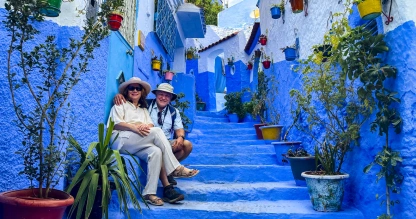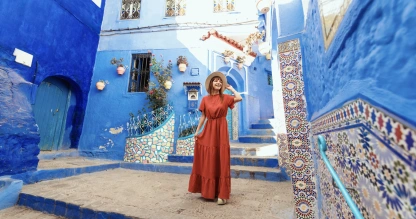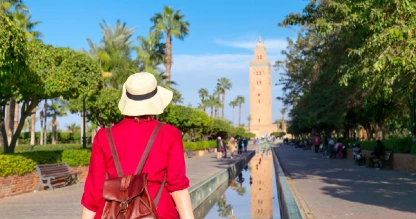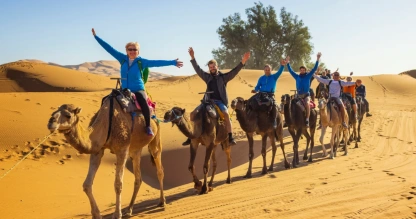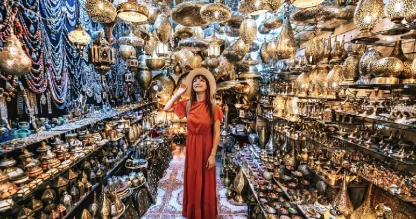
The City of Meknes
Meknes stands proudly as a UNESCO World Heritage Site and one of Morocco's four imperial cities. Travelers often overlook this gem despite its rich history. This bustling northern Moroccan city of nearly a million people traces its roots to an 11th-century military settlement by the Almoravids.
The city's imperial past comes alive through its extraordinary architectural wonders. Bab Mansour gate welcomes visitors with its impressive presence, built to honor Sultan Moulay Ismail. The massive Royal Stables once housed exactly 12,000 horses.
The 670-year-old Bou Inania Madrasa and the ancient Roman ruins of Volubilis are the most important cultural and archeological sites in the region. Located just 60 kilometers from Fez, Meknes showcases Morocco’s imperial grandeur and is a highlight often featured in Morocco travel packages.
Imperial Meknes: A City Built by a Sultan
Sultan Moulay Ismail took the Moroccan throne in 1672 and chose Meknes as his capital. He started a mission to turn this simple market town into a magnificent imperial city. His 55-year reign revolutionized what we now call one of Morocco's most important historical sites.
The legacy of Moulay Ismail
Sultan Moulay Ismail shared many traits with his contemporary Louis XIV of France. He aimed to build a legacy that would display his absolute power. His choice of Meknes over older cities like Fez or Marrakesh broke tradition. This calculated move helped him stay away from political rivals while creating a new center of power.
The city grew dramatically under his rule. The royal complex ended up becoming four times bigger than the medina itself. His construction projects hired between 25,000 and 25,000 workers. The workforce included paid laborers, slaves, and Christian prisoners of war. European ambassadors exaggerated stories about the scale of Christian slavery.
The Kasbah and royal palaces
The imperial city's defensive infrastructure stood out with its 40 kilometers of walls. These extraordinary fortifications made Meknes one of the medieval world's best-protected cities. Moulay Ismail built several palace complexes inside these walls.
Dar al-Kebira or "Great House" became the first and most important palace, completed in 1679. The Kasbah contained two additional major palaces: Dar al-Madrasa and Ksar al-Mhanncha. These royal homes showcased intricate zellige tilework, carved wood, and stucco decorations that reflected the era's luxury. The complex also featured reliable hydraulic systems, gardens, and the massive Heri al-Mansur palace with its huge stables built between 1721 and 1725.

Mausoleum of Moulay Ismail
The sultan's mausoleum stands as his most lasting monument, built during his lifetime. The site sits in the southwest section of the former Dar al-Kebira Palace. This location was chosen in part because people already saw it as sacred, thanks to the tomb of Sidi 'Abd ar-Rahman al-Majdub, a respected 16th-century Sufi mystic.
The exterior looks plain, but inside you'll find peaceful yellow courtyards leading to richly decorated chambers. The central room boasts a high cupola ceiling, ornate fountain, and twelve marble columns grouped in threes at each corner. Two antique grandfather clocks catch visitors' attention—Louis XIV of France's gifts.

Architectural Wonders You Shouldn’t Miss
Sultan Moulay Ismail's grand vision shaped Meknes Morocco's architectural treasures. The city's exceptional craftsmanship amazes visitors to this day. These structures show evidence of the city's golden age and let us learn about its past.
Bab Mansour and other monumental gates
Place el-Hedim's breathtaking Bab Mansour gate stands as one of North Africa's most magnificent entrances. This architectural masterpiece, 290 years old, showcases intricate zellige (geometric mosaic tilework), marble columns from Volubilis's Roman ruins, and carved stone elements.
A local story tells how architect Mansour el Aleuj showed the finished gate to Sultan Moulay Ismail. The ruler asked if he could build something better. His unwise "yes" reply cost him his life. The city has other remarkable gates too. Bab el-Khemis features distinct horseshoe-shaped arches, while Bab Berdaïne displays magnificent carved decorations.

Bou Inania Madrasa and Islamic schools
Meknes' finest example of Merinid architecture lives in the Bou Inania Madrasa, 680 years old. This Islamic school's courtyard and prayer hall showcase exquisite cedar wood carvings, delicate plasterwork, and remarkable geometric designs. Unlike most religious buildings in Morocco, this historic institution welcomes non-Muslims, giving them a rare look at traditional Islamic education.

Dar Jamai Museum and Andalusian design
The Jamai family's palatial home from the 19th century now serves as the Museum of Moroccan Art. The museum's Andalusian-style garden offers a peaceful escape from the busy medina. Visitors on a Morocco tour can admire magnificent traditional crafts inside - ceramics, woodwork, textiles, and jewelry. These items sit in rooms with ornate ceilings and zellige floors.
Habs Qara prison and its underground mystery
Habs Qara's massive underground prison shows a darker side of Meknes' history. This big subterranean complex held up to 40,000 prisoners. Today, people can explore the dimly lit chambers where prisoners were chained to walls.
Heri es-Souani granaries and stables
Sultan's architectural genius shines through the enormous Heri es-Souani complex. These huge granaries and stables used innovative vaulted ceilings with small windows. This design kept food at consistent temperatures while providing ventilation. The stables next door could house 12,000 horses, each with its own groom and slave. Morocco's advanced 17th-century engineering capabilities appear in the complex's remarkable water system and architectural design.

What to Do in Meknes for a Cultural Experience
Meknes, Morocco lets you experience authentic cultural immersion that goes beyond its imperial grandeur.
Explore the Medina and its souks
The ninth-century medina gives you a more relaxed shopping experience than Fez or Marrakech, while staying true to tradition. Narrow lanes lead to merchants who sell everything from decorative lamps to woven carpets at better prices than other Moroccan cities. You'll need to haggle to get authentic souvenirs.

Try Damasquinerie: Meknes' unique metal art
Meknes stands as the last city where damasquinerie runs on. This detailed craft embeds silver or gold wire into metal surfaces and creates stunning decorative items. The craft comes from Jewish heritage and produces beautiful vases, jewelry, and dishes. The award-winning Palais Damasquini workshop in Kobt Souk shows artisans from the Essaidi family at work on this ancient art.

Relax at Place Hedim
Sultan Moulay Ismail created this lively square in the 1670s after taking down part of the old city. The square now beats as Meknes' social heart. Evenings buzz with music, juice vendors, and carnival-like games. Many people see it as a smaller version of Marrakech's famous Djemaa el Fna.

Visit local mosques and religious sites
The city features many important mosques, including Lalla Aouda, Er Rouah, and Zitouna. The historic Grand Mosque stands out in the medina with its green-tiled roof. You can visit the Mausoleum of Moulay Ismail to see its beautiful mosaic decorations, but not on Friday mornings.

Day Trips from Meknes Worth Taking
Northern Africa's most important historical treasures lie just outside Meknes, Morocco. These remarkable sites make perfect destinations for unforgettable day trips.
Volubilis: Roman ruins with mosaics
UNESCO-protected Volubilis ruins stand 29 kilometers from Meknes and showcase Morocco's finest Roman heritage. This ancient city began its history in the 3rd century BC and flourished as Mauretania Tingitana's capital from 24-285 AD.
Beautiful mosaics still decorate the grand Roman villas, including the House of Orpheus and House of the Athlete. Visitors can discover the basilica's reconstructed columns, marvel at the Triumphal Arch of Caracalla, and explore extensive olive press remains that showcase the city's economic foundation.

Moulay Idriss: Morocco's holiest town
Moulay Idriss Zerhoun sits just 5 kilometers from Volubilis. The town's name honors Prophet Muhammad's great-grandson who brought Islam to Morocco in 789 AD. The town spreads across two hills and features Morocco's only cylindrical minaret that crowns the Sentissi Mosque. Visitors can stroll through pastel-colored streets and take in spectacular views from hillside terraces.
What to expect from Meknes
Meknes reflects Morocco’s imperial past, offering travelers an authentic glimpse into the nation’s heritage away from heavy tourist crowds. It provides unique cultural experiences to discover during Morocco Tours.

FAQS
Q1. Is Meknes, Morocco worth visiting?
Yes, Meknes is absolutely worth visiting. As one of Morocco’s imperial cities, it blends history, culture, and charm without the heavy crowds you’ll find in Fez or Marrakech.
Q2. How safe is Meknes, Morocco?
Meknes is generally safe for tourists. Like any travel destination, staying aware of your surroundings and taking normal precautions will ensure a smooth visit.
Q3. How much time do you spend in Meknes?
One to two days is usually enough to explore Meknes’s highlights, such as Bab Mansour, the Royal Stables, and the bustling medina.
Q4. What are the best day trips from Meknes?
The Roman ruins of Volubilis, the holy town of Moulay Idriss, and the city of Fez all make excellent day trips from Meknes.
Q5. What is the best time of year to visit Meknes?
Spring (March to May) and fall (September to November) are the best times to visit, offering mild weather and fewer tourists.
Ready to discover Morocco's magic? Explore our Morocco Travel Packages and enjoy the best of Middle East trips!



